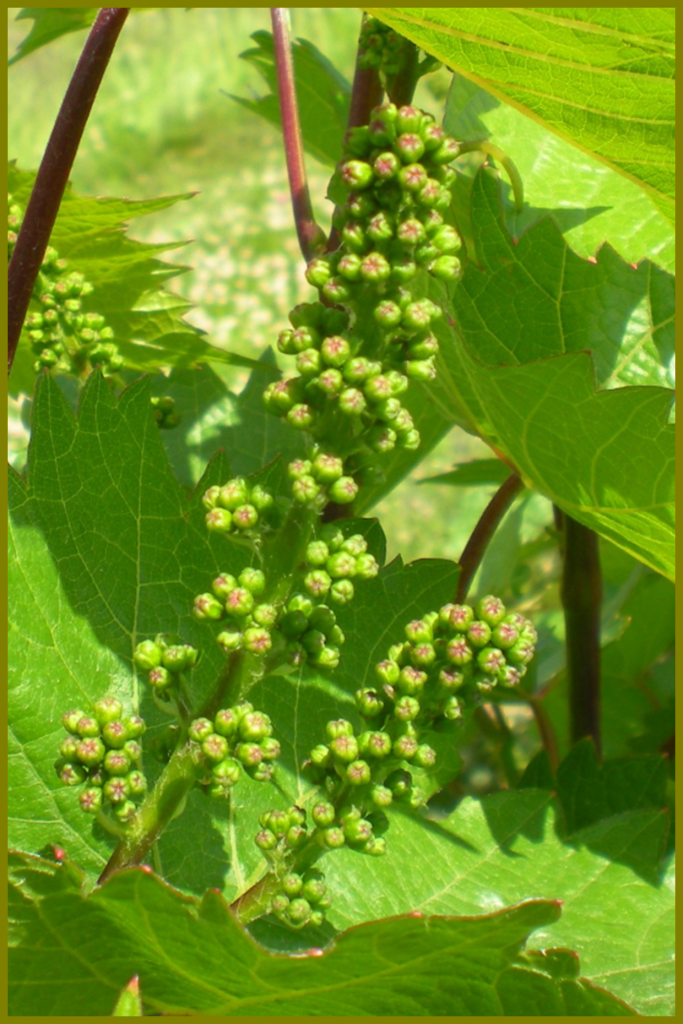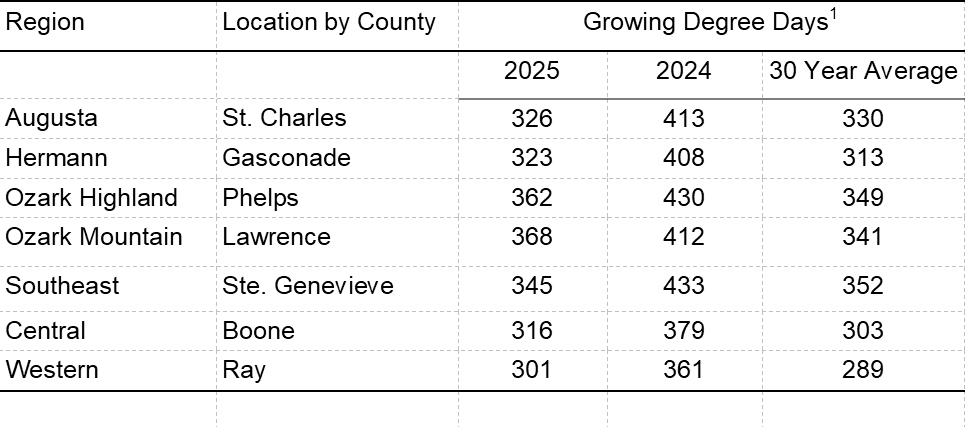Published on
Updated on

Vinews
Viticulture Information News
Week of 21 April, 2025
Columbia, MO
Contents:
- Immediate Pre-Bloom: Critical Period of Disease Management
- Grape Stage and Application Timing is Critical for Successful Disease Management
- With Bloom Approaching Remember Petiole Sampling
- Cool temperatures impact grapevine diseases and flowering
- Cumulative Growing Degree Days for Seven Grape Growing Regions of Missouri April 1 to May 5, 2025
Immediate Pre-Bloom: Critical Period of Disease Management

Figure 1. Inflorescence prior to Immediate Pre-bloom. See Figure 2 for comparison. Photo credit: D.S. Volenberg
There are three major stages in the growth and development of grape berries that require attention to detail for crop protection.
The period from immediate pre-bloom through 5 to 6 weeks post bloom is the most critical time to protect your crop from pathogens. This period is when your grape crop is the most susceptible to fungal pathogens.
As the phenology of the vines progress from vegetative growth to reproductive growth the potential for disease increases. Prior to pre-bloom disease management focused on keeping the shoots, leaves and developing inflorescences protected from disease. Depending on your vineyard location the inflorescence will soon begin flowering and this calls for increased vigilance to protect the crop from pathogens.
Right now we are entering the period where attention to detail will pay dividends at harvest. The immediate pre-bloom to 5 to 6 weeks post-bloom is when you should consider using your best disease management tools to control the grape disease complex.
Select fungicide products that will provide protection from phomopsis, black rot, downy mildew, powdery mildew, and anthracnose. These are the five major diseases of concern. Take some time now to plan for your next three cover sprays. This will help to avoid applying the same products repeatedly which can result in the selection for fungicide resistant pathogens. Depending on your past disease problems from last season as well as disease outbreaks that may have occurred this season consider using both systemic fungicides as well as protectant fungicides in a tank mix to protect your crop.
Phomopsis remains a threat, especially during the bloom period. During bloom Phomopsis spores can infect developing flowers. Phomopsis development remains dormant in developing berries until brix levels begin to rise starting at approximately 15 brix. Infected berries begin the rotting process and some infected berries shatter. The primary inoculum of Phomopsis declines as temperatures begin to rise Although grape berries are susceptible to Phomopsis throughout the growing season, reduced primary inoculum coupled with increasing temperature conditions reduce the threat of Phomopsis infections after the bloom period.
Also keep alert for Downy mildew, Black rot, and anthracnose infections. Extended wet periods during the critical period of immediate pre-bloom to post bloom are ideal conditions for infection by the diseases listed above. Consider applying a systemic fungicide tank mixed with a protectant fungicide to extend your spray cover window during extended wet periods.
Use The Best Fungicides To Protect The Crop: Avoid Repeat Applications Of The Same Fungicide And Fungicides From The Same Chemical Class
During the critical period (pre-bloom to 5 to 6 weeks post bloom) fungicides from two chemical classes are often applied. Fungicides from these two classes provide good protection to a broad spectrum of pathogens. The two classes of fungicides are the Qol fungicides=strobilurins (FRAC 11) and the DMI fungicides= sterol biosynthesis inhibitors (FRAC 3). Powdery mildew in Virginia, Michigan, Georgia, Missouri, and Oregon have been identified that are resistant to strobilurins or DMI fungicides. Downy mildew in Virginia and North Carolina has been identified that are resistant strobilurin fungicides. Therefore when planning your critical period spray program implement a spray program that avoids sequential applications of the same product or products within the same FRAC cade. Many of the labels of both strobilurins (Frac 11: Abound, Sovran, Flint) and sterol-inhibitors (Frac 3: Mettle, Procure, Rally or Tebuzol) limits the number of applications during the growing season. For example, the Rally label states that only 2 sequential applications of Rally or Rally and another product containing the same active ingredient as Rally or another Sterol inhibitor can be applied. Fungicides that contain more than one active ingredient (Pristine, Inspire Super, Revus Top, or Quadris Top) are also effective for broad spectrum disease management.
As the grape berries age they become resistant to some fungal diseases. Grape berries develop resistance to Black rot, downy mildew and powdery mildew approximately 3 to 6 weeks after bloom. Therefore early season disease management through post-bloom disease management are critical. Although berries develop resistance other green tissue remains susceptible throughout the growing season.
In Summary
- Timing is critical for fungicide applications, be sure you know how to identify the immediate pre-bloom stage (Figure 2).
- Keep spray intervals at 7 to 10 days starting from immediate pre-bloom through post-bloom.
- Ensure thorough spray coverage. If rain is forecast and your last spray was applied 7 to 10 days ago, then spray prior to the forecast rain event.
Grape Stage and Application Timing is Critical for Successful Disease Management
- Immediate Pre-Bloom
- When the florets of the inflorescence separate from apart from each other (Figure 2).
- Bloom
- When 50% of the inflorescences have 50% of the flowers open
- Length of bloom is often 5-to7-days but can be longer if cool temperatures prevail during bloom.
- Post Bloom
- When the fruit begins to set. Grape berries are very susceptible to infection by diseases until 5 to 6 weeks post bloom.

Figure 2. Inflorescence of grape showing the florets tightly clustered (A) and inflorescence of grape showing the florets separating which is the growth stage of immediate pre-bloom (B). Photo credits: D. S. Volenberg.
With Bloom Approaching Remember Petiole Sampling
Figure 3. Grapevine inflorescence during flowering. Petiole sampling should take place when 70% of the caps have shed. Photo credit: D.S. Volenberg

Grape growers that have vineyards just coming into fruit production often have questions about vineyard nutrient management. The questions often have to do with the when and why they should monitor the nutrient status of the vines. Tissue analyses or petiole sampling is normally undertaken for two reasons; routine nutrient status evaluation and to diagnose an observed suspected nutrient deficiency.
The routine assessment of the vines nutritional status should be done at a specific phenological stage. These phenological stages are full flowering (Figure 3) and veraison. Full flowering can be defined as when 70% of the caps have been shed, whereas veraison is the onset of rapid fruit maturation, where visually a distinct color change is occurring. This color change is obviously more distinct in red varietals than white varietals. In white varietals, the color change often is from a dull green to a lighter transparent yellow.
The goal of routine nutrient assessment is to gauge the response of the vines to nutrient additions or determine the vine’s nutrient needs. The overall objective is to maintain the nutrient balance to produce high quality grapes by applying only nutrients that are needed, thereby saving money and also protecting the environment.
Petioles are collected from different locations on the shoot depending on the sampling period – full flowering or veraison. At full flowering you select leaves that are opposite of the flower clusters. Whereas at veraison, the 6th or 7th leaf from the shoot tip, which is the most recently fully expanded mature leaf is selected. Avoid collecting leaves from laterals. Once a leaf is collected, break the petiole (leaf stem) away from the leaf blade and discard the leaf blade. You will need to collect 60 to 100 petioles for a sample. These petioles should come from 25 to 50 different vines, but be of the same variety, rootstock, and soil type. If your vineyard has variable soil types, divide your vineyard into blocks and petiole sample each block.
In the case of trying to diagnose a suspected nutrient imbalance in a vine(s), you may only be able to select leaf samples from one or a few vines. Select leaves that are showing the suspected deficiency, but do not collect petioles from leaves that are insect, disease, or mechanically damaged. In addition to this sample, also collect petioles from the same variety that is not showing the deficiency. Send in both samples to be analyzed. You will then have results to compare from a healthy vine(s) and those vine(s) showing a deficiency.
Petioles should be stored in a paper bag to allow the petioles to dry. Petiole samples can be dropped off at University of Missouri County Extension Centers and will be analyzed by the University of Missouri Soil Testing and Plant Diagnostics Services.
Cool temperatures impact grapevine diseases and flowering
Pestalotiopsis

Figure 4. Pestolotiopsis spp. symptomology on Chambourcin during early May. Photo credit: D.S. Volenberg
I first reported on Pestalotiopsis spp. in 2015 when it was first observed in Missouri as a fruit rot in a Norton vineyard. The very first report of Pestolotiopsis spp. was as a trunk disease in Vignoles, Chambourcin, Norton and Traminette. The specific pathogen isolated from the grapevine trunks was Pestalotiopsis uvicola as well as an unidentified Pestolotiopsis sp (Urbez-Torres et al. 2012). Dr. Jim Schoelz and I have further isolated Pestolotiopsis sydowiana and Pestolotiopsis microspora from symptomatic Chambourcin grape leaves.
Pestolotiopsis is an endophyte that lives within the grapevine part of its life cycle without causing disease. Since 2015, I have documented Pestolotiopsis causing a leaf blight in Chambourcin every spring shortly after new shoot growth begins (Figure 4). The symptomology in Chambourcin is very striking as the young leaves display a carmine red blight. In comparison, the symptomology is very muted in Vignoles causing a light yellow leaf blight.
A grower from Kansas reached to me asking about this disease this week in Chambourcin. I explained, I have never seen the disease cause leaf drop except once. In this case the Chambourcin vineyard did not receive its first protective spray until the shoots were 18 to 24-inches. This resulted in significant leaf drop.
Laboratory research and field observations have demonstrated there are fungicides that provide control of Pestolotiopsis. In laboratory experiments, Pristine, Captan and Manzate Pro-Stick all reduce fruit rot caused by Pestolotiopsis. In the vineyard, protective sprays of mancozeb products eliminate leaf drop caused by Pestolotiopsis spp.
Reference cited:
Urbez-Torres, J. R., F. Peduto, R.K. Striegler, K.E. Urrea-Romero, J.C. Rupe, R.D. Cartwright and W.D.Gubler, 2012. Characterization of fungal pathogens associated with grapevine trunk diseases in Arkansas and Missouri. Fungal Diversity 52:169-189.
Flowering
Cool temperatures are resulting in an extended flowering period for our southern border neighbors in Arkansas. The flowering period can provide an entry for pathogens into the developing fruit. Disease pathogens such as Phomopsis viticola and Botrytis can enter developing berries during flowering. With an extended flowering period there are extended opportunities for disease infection.
Cumulative Growing Degree Days for the Seven Grape Growing Regions of Missouri from April 1 to May 5, 2025.

1Growing degree days at base 50 from April 1 to May 5, 2025. Data compiled from U2U Decision Support Tools – Corn GDD
To determine the number of growing degree days accumulated in your area since April 1. Use this tool.
Please scout your vineyards on a regularly scheduled basis in an effort to manage problem pests. This report contains information on scouting reports from specific locations and may not reflect pest problems in your vineyard. If you would like more information on IPM in grapes, please contact Dean Volenberg at 573-473-0374 or volenbergd@missouri.edu